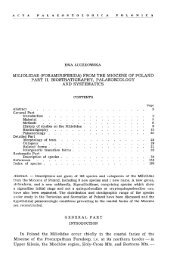The skull of Velociraptor - Acta Palaeontologica Polonica
The skull of Velociraptor - Acta Palaeontologica Polonica
The skull of Velociraptor - Acta Palaeontologica Polonica
Create successful ePaper yourself
Turn your PDF publications into a flip-book with our unique Google optimized e-Paper software.
ACTA PALAEONTOLOGICA POLONICA (44) (2) 197<br />
Fig. 3. A, B. Deformed <strong>skull</strong> and mandible <strong>of</strong> <strong>Velociraptor</strong> mongoliensis, GIN 100124, in right lateral (A)<br />
and dorsal (B) views. Scale bar 2 cm.<br />
thors may be incorrect. <strong>The</strong> respective regions <strong>of</strong> maxillae are damaged in Dromaeo-<br />
saurus. To our knowledge, such a long and shallow maxillary process occurs only in the<br />
Ornithomimidae (a long process is also present in the Oviraptoridae, but its form is in-<br />
comparable to that in the dromaeosaurids: Barsbold, Maryariska, & Osm6lska in prepa-<br />
ration). <strong>The</strong> maxillary process <strong>of</strong> the premaxilla separates the maxilla from the narial<br />
border only in some theropods, among them in the earliest ones, the Triassic Eoraptor<br />
Sereno et al., 1993 and Herrerasaurus Reig, 1963 (Sereno & Novas 1992), but also in<br />
the Late Jurassic Ornitholestes Osbom, 1903, Sinraptor Currie & Zhao 1994) and the<br />
Cretaceous tyrannosaurids. <strong>The</strong> maxilla forms a part <strong>of</strong> the narial margin in Compso-<br />
gnathus, the ceratosaws, allosaurids, therizinosaurids (Erlikosaurus), troodontids, and<br />
Archaeopteryx. <strong>The</strong> symphyseal edge <strong>of</strong> the premaxilla is rostroventrally inclined in<br />
Deinonychus whereas it is perpendicular to the long axis <strong>of</strong> the <strong>skull</strong> in <strong>Velociraptor</strong>.<br />
<strong>The</strong> maxilla in Deinonychus is relatively deeper caudally than that in <strong>Velociraptor</strong>, and<br />
the rostral margin <strong>of</strong> the internal antorbital fenestra is subtriangular, whereas this<br />
fenestra is broadly rounded rostrally in <strong>Velociraptor</strong>. Deinonychus and Dromaeosaurus<br />
lack the longitudinal ridge which runs above the alveolar border in <strong>Velociraptor</strong>. <strong>The</strong><br />
outer surfaces <strong>of</strong> the maxillae in both North American genera are marked by more nu-<br />
merous neuro-vascular foramina, which are less regularly spaced, whereas these foram-<br />
ina are arranged in a single row in <strong>Velociraptor</strong>. <strong>The</strong> promaxillary fenestra is slit-like in<br />
Deinonychus, but not in all <strong>skull</strong>s <strong>of</strong> <strong>Velociraptor</strong>, but otherwise the maxillary recesses<br />
seem comparable to those in <strong>Velociraptor</strong>. <strong>The</strong> nasal <strong>of</strong> <strong>Velociraptor</strong> resembles that <strong>of</strong><br />
Deinonychus in being relatively long, and in having the lateral and dorsal surfaces at<br />
right angles to each other, the dorsal one very narrow. However, in Deinonychus, the<br />
pr<strong>of</strong>ile <strong>of</strong> the nasal slopes uniformly towards the rostral extremity <strong>of</strong> the snout, whereas

















